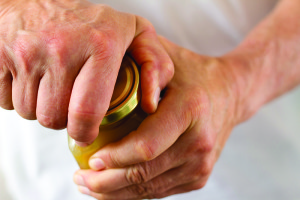By Lisa M. Cyr, OTD, OTR/L, CHT – Occupational Therapist / Hand Therapist, OrthoConnecticut
OSTEOARTHRITIS (OA) is one of the most common joint disorders and is one of the leading causes of disability in the United States. It affects as many as 12% of the American population over 25. One in 4 women and at least 1 in 12 men will suffer from the pain and loss of function caused by osteoarthritis (OA) of the carpometacarpal joint (CMC) of the thumb during their lifetimes. When the smooth cartilage covering the ends of the bones in the thumb wears away, the bones rub against each other, causing friction and damage to the bones and the CMC joint. This can cause severe pain, swelling, and decreased strength and range of motion, making it difficult to do simple daily tasks. This may lead to loss of function, depression and decreased quality of life, causing many people to ultimately seek surgical intervention for relief.
There are many potential causes for arthritis at the base of the thumb. Since the thumb is involved in at least 40% – 50% of every task that we do with our hands, it is subjected to many forces and strains throughout each day. Each time we pinch something between the fingertip and thumb tip, there is up to 25 times more force at the CMC joint than at the tip! Straining to open a new jar, holding a pen tightly when writing, buttoning tight buttons, pulling tight weeds, twisting a key in a stiff lock, trying to pull open a new bag of cereal or chips, holding pliers or other tools or overly large cups are all examples of ways we repeatedly strain our thumbs each day. Texting, with its repeated thumb motion, can irritate an already inflamed CMC joint.
These techniques are most effective when incorporated early in the disease when people first notice twinges of pain at the base of the thumb with pinching or gripping activities.
Research shows that the disabling effects of basal joint disease can be minimized with conservative interventions such as joint protection strategies, short term immobilization to rest the painful joint, and hand exercises.
A referral to a skilled Occupational Therapist/Hand Therapist for two or three sessions can help significantly decrease pain at the base of the thumb, and enable people to continue doing the activities most important for their quality of life. A skilled Occupational Therapist/Hand Therapist accomplishes this by educating the patient in joint protection techniques and adaptive equipment. Patients are either fitted with a custom thumb stabilizer or educated about an over the counter soft support to help rest the painful CMC joint. The patient is given a home exercise program to help delay the progression of the arthritis. These simple techniques have been shown to dramatically improve pain and function for many people with basal joint arthritis.



















